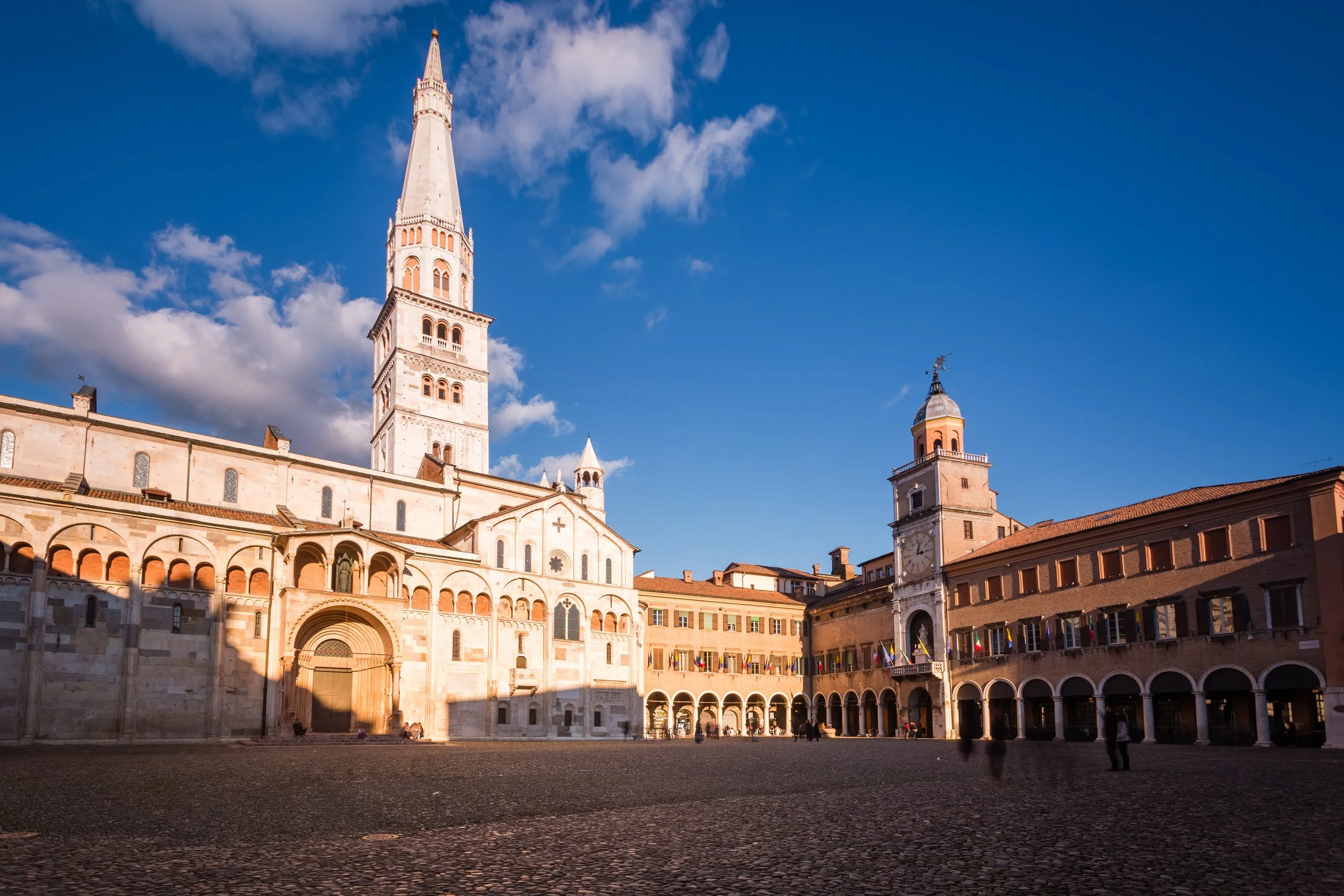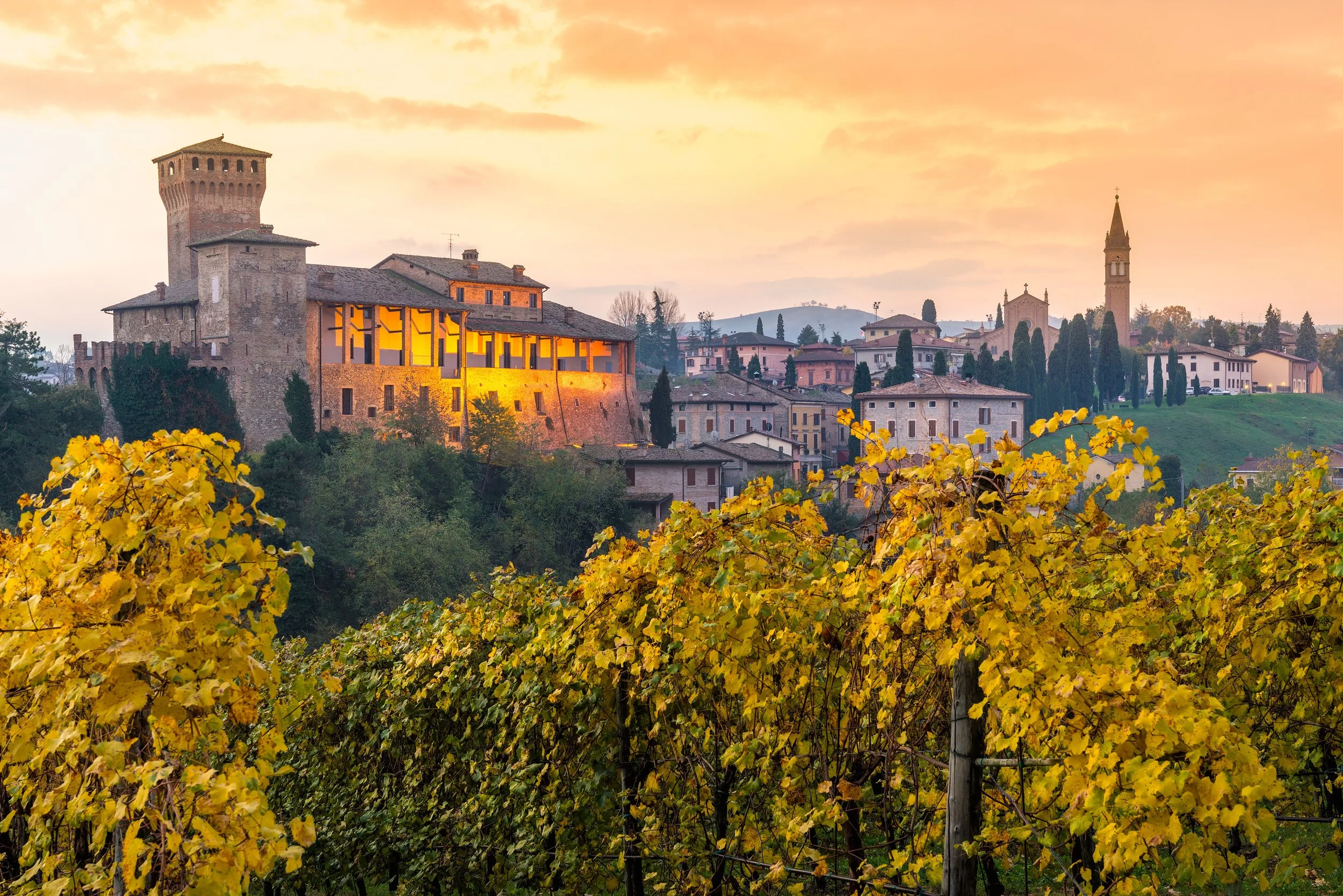Part 3 – Lambrusco at the Culinary Heart of Emilia Romagna
Walk under Bologna’s porticoes at aperitivo hour, or browse Modena’s Albinelli market as salumi are paper-thin sliced and Parmigiano-Reggiano is freshly cracked—one detail repeats itself: the friendly pop of a cork and the lively fizz of Lambrusco. This is not a single wine but a family of native grapes from the plains and hills around Modena, Reggio Emilia, Parma, and Bologna, crafted into styles that move effortlessly from trattoria to Michelin-starred dining.
Lambrusco’s place at the table is no accident. The local cuisine—rich pastas, noble cured meats, aged cheeses, and the sweet-savory punctuation of aceto balsamico tradizionale—asks for refreshment, lift, and grip. Lambrusco answers with sparkle, tang, and just enough tannin. As the poet Giosuè Carducci famously put it:
“God purposely made Lambrusco to marry meat.”
The ancient Duomo di Modena
What “Lambrusco” Means Today
Lambrusco is both the name of the wine and a cluster of related native grape varieties. Most bottlings are red; some are rosé. Nearly all are sparkling—either lightly (frizzante) or fully (spumante). And sweetness ranges from secco (dry) to amabile (semi-sweet) to dolce (sweet), which is why it can star at brunch, with pizza, or alongside slow-braised meats. (For the official overview of origins and styles, see the Consorzio Tutela Lambrusco.) lambrusco.net+1
If you remember only one thing: Lambrusco is a spectrum, not a stereotype.
The Main Personalities (DOC styles you’ll actually see)
Lambrusco di Sorbara – the most delicate: pale ruby to rosato, floral (violet), tart red berries; often best slightly chilled and paired with salumi or fried snacks. lambrusco.net
Lambrusco Salamino di Santa Croce – fruit-forward and zippy, with easy cherry notes and a friendly, all-purpose attitude. lambrusco.net
Lambrusco Grasparossa di Castelvetro – the boldest and darkest: deep color, firmer tannin, ripe black fruit; the go-to when the food gets richer. Many locals call it the king of Lambrusco for that authority at the table. lambrusco.netvisitmodena.it
(Travel planners: regional tourism and city sites point you straight to cellar doors and Lambrusco routes, especially around Castelvetro, Modena, and the Reggio countryside.) visitmodena.itvisitemilia.com
Castelvetro di Modena a small medieval hill town at the center of all things Lambrusco
Why It Works with Emilia-Romagna’s Icons
Think about the region’s “greatest hits”: tortellini in brodo, lasagne, Prosciutto di Parma, Mortadella, and Parmigiano-Reggiano; then the crown jewel of condiments, traditional balsamic vinegar. The cooking is generous and savory; it needs a wine that cleanses and connects.
Bubbles = refreshment. Effervescence acts like a palate reset between bites of fat-rimmed coppa or mortadella.
Acidity = lift. Tangy brightness loves aged cheeses and balsamic’s sweet-sour depth.
Tannin = traction. Rare for sparkling reds, Lambrusco’s gentle tannins give grip with roasted meats and ragù.
This is codified in countless pairing guides and dining rooms, from Modena to Parma. Matching Food & Wine
Mercato Albinelli, a historic covered market that has been part of Modena’s heritage since the Middle Ages
“Tradition, Critically—Not with Nostalgia”
No contemporary voice channels Emilia-Romagna’s food identity more clearly than Massimo Bottura of Modena’s Osteria Francescana. His philosophy is a perfect explainer for Lambrusco’s modern renaissance:
“Per costruire il futuro bisogna guardare il passato. Ma non con nostalgia.”
(“To build the future you must look to the past, but not with nostalgia.”) Facebook
And on the kitchen approach that birthed new respect for local classics:
Look at tradition “critically and not with nostalgia.” Eater
Those lines could describe Lambrusco’s journey over the last two decades: a shift from sugary caricature to site-specific, food-first wines that taste unmistakably of Emilia-Romagna—just updated for today’s tables. The Consorzio itself emphasizes these roots and the wine’s millennia-long bond with the territory. lambrusco.net
A Third Voice at the Table
Italy’s legendary wine intellectual Luigi Veronelli once celebrated Lambrusco’s unpretentious joy:
“I want to explain to the world why Lambrusco is the only wine of freedom.” Do Bianchi
Read it as a call to drink the wine where it makes sense: with friends, with food, with laughter—a democratic, daily pleasure.
How to Choose (Quick Guide for First-Timers)
Want light and floral? Try Sorbara (often rosé-leaning).
Pizza, salumi, weeknight pastas? Salamino is fruit-driven and versatile.
Braised meats, aged cheeses, balsamic-glazed roasts? Grasparossa brings color, structure, and that decisive tannic handshake.
Official regional listings confirm you’ll encounter these across Modena and Reggio Emilia—often in secco, amabile, or dolce versions—plus lesser-known branches like Marani, Maestri, Montericco, and Ancellotta appearing in blends. visitemilia.com
Where This All Leads: Rosso Fosco Lambrusco Grasparossa di Castelvetro, Extra Dry DOC
Everything above—history, styles, pairings—funnels straight into Rosso Fosco, our featured Lambrusco Grasparossa di Castelvetro from Cantina Formigine Pedemontana. It is:
Deep red and fully sparkling, with blackberry, black cherry, and violet notes.
Secco/extra dry, so it refreshes rather than cloys.
Firmly tannic for a sparkling red, thanks to the Grasparossa grape’s thicker skins—this is the structural edge that sets it apart from Sorbara and Salamino.
City and tourism resources describe Grasparossa precisely this way—more body, more structure—making it the natural choice when the menu runs toward bolliti misti, cotechino, ragù, and aged cheeses. In short: the king of Lambrusco where richness reigns. visitmodena.it
Taste the Region in One Pour
To many travelers, Emilia-Romagna is “Food Valley.” UNESCO designations, centuries-old courts and cookbooks, and the legacy of Pellegrino Artusi all underline the region’s leadership in Italian taste. The official tourism portal frames it as a living museum of PDO/PGI specialties—from Parmigiano-Reggiano to Prosciutto di Parma and Traditional Balsamic Vinegar—that still anchor contemporary life. Travel Emilia Romagna
Lambrusco belongs in that same conversation: born of the place, made for the food, and meant to be shared. Pour a glass of Rosso Fosco alongside tortellini in brodo, a slice of 36-month Parmigiano, or a platter of Parma prosciutto, and the logic becomes deliciously obvious.
To learn about our other products check out some of our articles on Traditional Balsamic Vinegar of Modena
Sources & Further Reading
Consorzio Tutela Lambrusco – history, denominations, style overviews. lambrusco.net+2lambrusco.net+2
Visit Modena (official) – concise profile of Lambrusco Grasparossa di Castelvetro and cellar-visit info. visitmodena.it
Visit Emilia / Travel Emilia-Romagna (official tourism) – product map of PDO/PGI foods; Lambrusco families and areas. visitemilia.comTravel Emilia Romagna
Matching Food & Wine – practical pairing guidance for Lambrusco with regional classics. Matching Food & Wine
Massimo Bottura on tradition, critically not nostalgically (interview & media). EaterSky TG24
Giosuè Carducci on Lambrusco and meat (context of the letter to Contessa Lovatelli). Eventi Culturali Magazine
Luigi Veronelli – “the wine of freedom” (Reggio Emilia speech, translated). Do Bianchi


